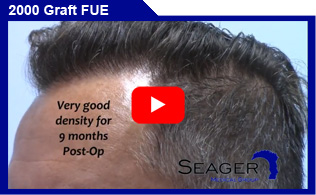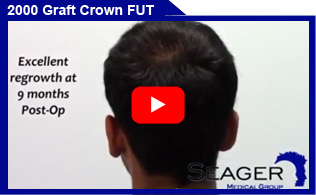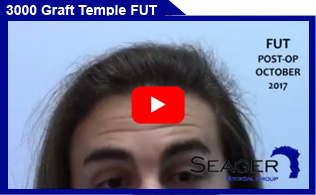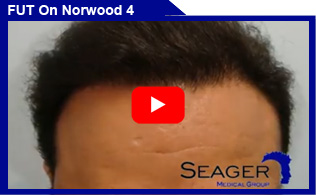Other Causes of Hair Loss
Androgenetic Alopecia is by far the most common cause of hair loss but there are a number of other causes.
Some causes are temporary and some causes, unfortunately, can be permanent.
Causes of Temporary Hair Loss
Telogen Effluvium is a common condition in which a physical or severe emotional stress can cause the root of a growing hair to stop growing and go through the growth cycle to become a resting root. The hair is shed easily and more hair than usual is seen on your brush, pillow, in the bath or shower, or when you run your hands through your hair. As an example, many women will go through Telogen Effluvium after they deliver a baby. The hair will usually be much better within six months after the stress has stopped. Less often, people can experience long-lasting, Chronic Telogen Effluvium. If people who have Androgenetic Alopecia experience Telogen Effluvium as well, they may shed hair then find that it does not all grow back. In general, if you experience a fairly rapid deterioration in your hair and you shed a lot more hair than the normal 100 hairs per day, you are very likely experiencing Telogen Effluvium. You should consult your doctor to be sure but there is a good chance that your hair will get better by itself. Hair transplantation is not recommended for active Telogen Effluvium because Telogen Effluvium will usually get better by itself and if there is ongoing Telogen Effluvium, the transplanted hair is not immune to the process.
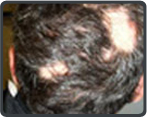 Alopecia Areata is also a fairly common condition. People with Alopecia Areata tend to notice a sudden loss of hair in one or more circular or oval patches. Rarely, there can be a diffuse, widespread, patchy loss. Alopecia Areata as a condition in which the body’s immune system short-circuits and the body attacks its own hair. Quite often, the condition fixes itself and the hair grows back. Sometimes the hair that grows back is white. If the doctor confirms the diagnosis of Alopecia Areata, he or she can sometimes speed up the recovery by injecting cortisone-type medications into the affected areas. Rarely, Alopecia Areata can lead to permanent hair loss in an area. Hair transplantation should not be considered when there is active Alopecia Areata, since the transplanted hair can be destroyed. Some surgeons will never consider hair transplantation into areas of Alopecia Areata for fear that they will reactivate the illness. At the Seager Hair Transplant Centre, we, like most hair transplant surgeons, will consider hair transplantation after it is clear that the Alopecia Areata has not been active for at least one and preferably for two years.
Alopecia Areata is also a fairly common condition. People with Alopecia Areata tend to notice a sudden loss of hair in one or more circular or oval patches. Rarely, there can be a diffuse, widespread, patchy loss. Alopecia Areata as a condition in which the body’s immune system short-circuits and the body attacks its own hair. Quite often, the condition fixes itself and the hair grows back. Sometimes the hair that grows back is white. If the doctor confirms the diagnosis of Alopecia Areata, he or she can sometimes speed up the recovery by injecting cortisone-type medications into the affected areas. Rarely, Alopecia Areata can lead to permanent hair loss in an area. Hair transplantation should not be considered when there is active Alopecia Areata, since the transplanted hair can be destroyed. Some surgeons will never consider hair transplantation into areas of Alopecia Areata for fear that they will reactivate the illness. At the Seager Hair Transplant Centre, we, like most hair transplant surgeons, will consider hair transplantation after it is clear that the Alopecia Areata has not been active for at least one and preferably for two years.
Anagen Effluvium is a rapid shedding of hair that is most well-known as a side effect of certain regimens of cancer chemotherapy. There are other medications and causes that can lead to Anagen Effluvium. Within six months of stopping the medications, the hair is usually much better. Hair transplantation is not required.
 Traction Alopecia is caused by repetitive, continuous pulling of hairs, most commonly caused by certain hairstyles. The most common hairstyle to cause Traction Alopecia is the wearing of tight braids or corn-rows. Wearing a tight topknot under a turban also causes Traction Alopecia. Usually the hairs in the hairline are pulled the tightest so they are the most affected. In the early stages, changing the hairstyle will solve the problem and the hair will grow back. There can be permanent hair loss if the hairstyle is not changed. If there has been permanent hair loss and there will not be further traction, hair transplantation is a very good option.
Traction Alopecia is caused by repetitive, continuous pulling of hairs, most commonly caused by certain hairstyles. The most common hairstyle to cause Traction Alopecia is the wearing of tight braids or corn-rows. Wearing a tight topknot under a turban also causes Traction Alopecia. Usually the hairs in the hairline are pulled the tightest so they are the most affected. In the early stages, changing the hairstyle will solve the problem and the hair will grow back. There can be permanent hair loss if the hairstyle is not changed. If there has been permanent hair loss and there will not be further traction, hair transplantation is a very good option.
Trichotillomania is a condition in which people give in to urges to repeatedly pull or twist their hair. Affected individuals find these urges very difficult to resist. The hairs usually break but, over time, the roots can be affected the same way they are affected in Traction Alopecia. People with Trichotillomania are often embarrassed by their condition and won’t readily admit that they have the problem or that it is still active. There are clues that a doctor can recognize that the problem is ongoing. The most important treatment for the hair loss due to Trichotillomania is to stop the hair pulling. This is easier said than done but there are treatments available. If you, or someone you know, have Trichotillomania it would be best to see your doctor to get help. Once the hair pulling has stopped, if there has been permanent hair loss, hair transplantation can be an option. Of course, transplanted hair will be damaged if the hair pulling resumes.
Causes of Permanent Hair Loss
Scars caused by burns, cuts, trauma, or chemicals can cause permanent hair loss. Hair restoration can be a very good solution.
Triangular Alopecia causes permanent hair loss in a triangular or oval shape in the front or side of the scalp that is present from birth. Hair transplantation can be very effective.
Senile Alopecia is the gradual thinning of hair over the entire body, including the scalp, as we reach advanced age.
Fortunately, other than Androgenetic Alopecia and some of the conditions mentioned above, conditions that cause permanent hair loss are not common.
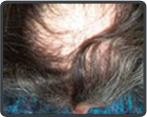 There are many other different causes such as Lupus, Scleroderma, and Progressive Scarring disorders that would be very difficult for you to diagnose yourself. In fact, most physicians who are not hair experts would be unfamiliar with many of these conditions. We won’t go into further detail here.
There are many other different causes such as Lupus, Scleroderma, and Progressive Scarring disorders that would be very difficult for you to diagnose yourself. In fact, most physicians who are not hair experts would be unfamiliar with many of these conditions. We won’t go into further detail here.
If you have hair loss in an unusual pattern, or you have scarring as evidenced by a lack of pores, shiny or hard or different colored skin, or you have evidence of inflammation such as redness, scaling, swelling, itching, bumps, or pain, you should consult a dermatologist to determine the cause and treatment options for your hair loss.
BACKThe Seager Advantage!
 Find out how countless satisfied clients lives are being transformed by the Seager Advantage
Find out how countless satisfied clients lives are being transformed by the Seager AdvantageWhy Do Some People Lose Their Hair?
Ask Any Questions Below
When it comes to hair restoration there are no "bad questions", we invite you to send us your questions and have them answered directly by our highly experienced Seager medical doctor, simply fill in the form below for a hair transplant consultation.No pressure, No Obligation. Steps to hair restoration

